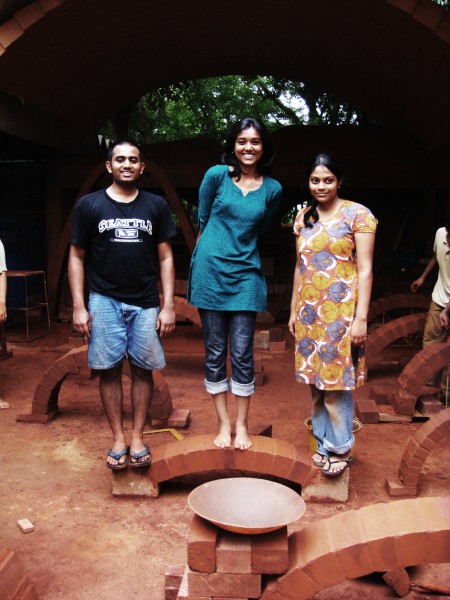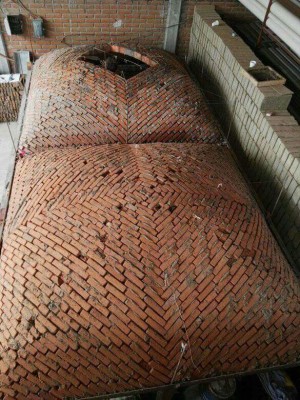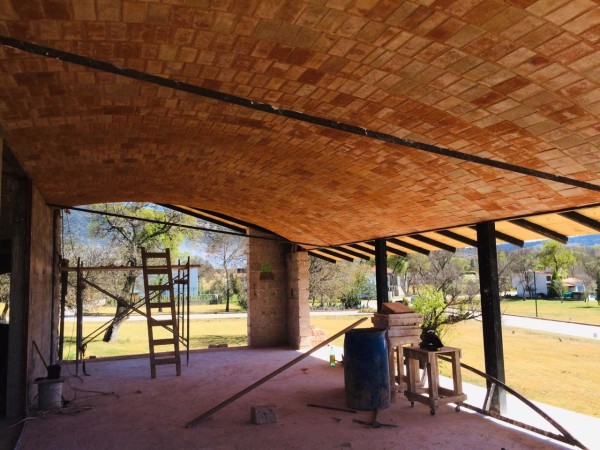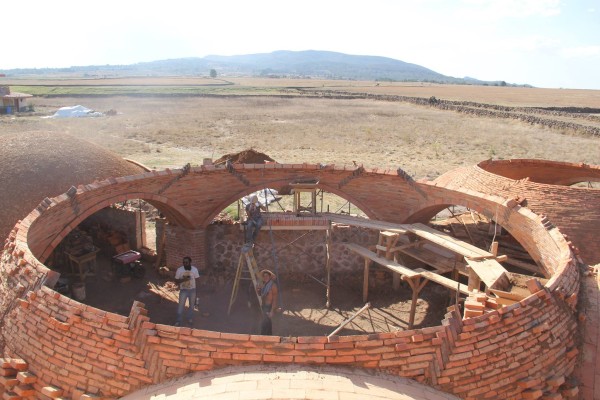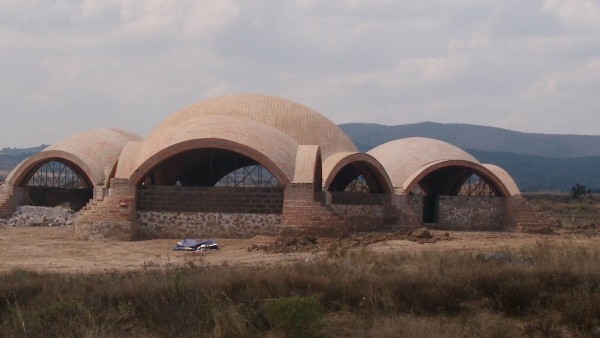Vaults and Domes
Varun Thautam – Apprenticeship – Vaults and Domes
(Updated – July 2019)
My love for the art of building with vaults and domes started at the UNESCO Chair Earthen Architecture – Asia, Auroville back in 2008. Over the past 10 years, practicing as an architect – dome builder, I have risked the enthusiasm and trust that several clients have placed in me to experiment in their projects. Several of these experiments were aimed to unearth some of the pieces of the lost art of designing and building with vaults and domes. Failures continue, vaults fall, material, labor, money and time is lost. Every time that happens in a live project, the trust of someone who believed in us is diluted. Yet we continue, as with each experience more of the lost art is unearthed, and more people understand the language of this art.
When I came to Mexico, I had a very strong foundation on the scientific methods and tools used to design and build vaults and domes. Imagining and calculating curves under compression was a mathematical and geometrical approach – pure mathematics and physics. The past 5 years here in Mexico have been such a spectacular unlearning and learning process. The master vault and dome builders here surprised me with the complete intuitive approach to this – pure art. I have been closely observing the masters of Ar.Ramon Aguirre defies gravity with his Gaussian curves. There is Maestro Andres Flores (a third generation bovedero) who can build as effortlessly and imaginatively as an ant; as if his body and soul were connected with his creations. On the other hand, there are masters like James Anthony who treat this artistic profession as meticulously and religiously as a spider builds a web. Using the body as a measure has helped then evolve a form to intuitive building, that cannot be easily explained by rational science. As their humble student, I am privileged to have been growing in the rational and intuitive methods.
Maestro Andres says..sharing is the best method to learn and grow. I humbly take this opportunity to prepare myself to consolidate my learning and seek opportunities to learn further through visits of artisans and learn from teachers who are willing to share. I would be keen on sharing through involvement in live projects, teaching short term workshops, or academic semester’s integrated with design-build teaching practice. I have a growing collection of information prepared for diffusion; in the format of presentations, interactive learning sessions and flexible modules of practical construction. Over the past 4 years, I have shared them in formats of lectures and workshops in Mexico and India. A list of themes that I speak and teach are attached.
Please feel free to write to me at vtarchitect@gmail.com in case you are interested in this theme, or would like to involve me in a project/course, or are able to connect me with teachers and artisans willing to share their knowledge.
Download the following themes as a pdf.
Theory
History and Symbolism
History of Curves and Arches
History of Vaults and Domes, examples and aspects of design
Symbolism, Meaning, terminology
Materials and their properties
Adobe, Bricks, blocks and stone
Thermal mass, insulation, humidity buffering, climatic design
Types of mortars – Mud, Lime, Cement and gypsum plaster
Design of strength, Loading, slenderness, eccentricity
Control of drying and contraction of mortars
Quality control of mortars
Structural Design and Calculations
Concepts of structural design of Masonry, limit state
Structural design using catenary method (Gaudi’s and Guastavino’s method)
Structural design using funicular method (Auroville earth Institute)
Intuitive methods of construction using body as a measure and guide (system of mexican bovederos) – origin: Master Andres Flores
Concepts of foundations, piers, buttresses, beams and ties to receive Arches, vaults and domes.
Construction and Organization of work
Tracing of curves, preparing of guides, forms and scaffolds
Site organization and management of teams
Basics of quality of workmanship and control of human error
Cost and time of construction
International codes and norms
Personal and shared experiences
Impermeabilization and waterproofing
Presentation of trial and errors
Presentation of work process of artisans around the world
Practicals
Tracing of curves, preparing of forms and scaffoldings, building of arches and small vaults (basics)1
Practice of hemispherical domes with mud (level 1)1
Practice of cloister domes / nubian vaults with mud (level 2)1
Practice of shallow catenary vaults with mud (level 3)1
Practice of Mexican vaults with mud (level 4)1
Practice of Groined segmental dome with mud (level 5)1
Practice of Mexican / freeform vault with Lime / cement (Level 6)2
Practice of Catenary Vault with lime/ cement (Level 7)2,1
Practice of a Catalan Vault with Gypsum Plaster (Level 8)3,1
Sobre Varun Thautam (instructor de bóvedas pegado con tierra)
www.varunthautam.com
Mi amor por el arte de construir con bóvedas y cúpulas comenzó en la Cátedra UNESCO Earthen Architecture (Auroville, India) en 2008. Durante estos últimos 10 años, en mi práctica como arquitecto y constructor de cúpulas, he arriesgado el entusiasmo y la confianza que varios clientes han depositado en mí para experimentar en sus proyectos.
Varios de estos experimentos tenían por objetivo desenterrar algunas de las piezas del arte perdido de diseñar y construir con bóvedas y cúpulas. Las fallas continúan, las bóvedas caen, se pierde material, mano de obra, dinero y tiempo. Cada vez que esto sucede en un proyecto en vivo, la confianza depositada en nosotros se diluye. Sin embargo, continuamos. Con cada experiencia se desentierra más el conocimiento del arte perdido de las bóvedas y cúpulas, y más personas entienden su lenguaje.
Cuando vine a México, contaba con una base muy sólida en los métodos y herramientas científicos utilizados para diseñar y construir bóvedas y cúpulas. Imaginar y calcular curvas bajo compresión era un enfoque matemático y geométrico: ciencia pura. Pero los últimos 4 años en México han supuesto un proceso espectacular de deconstrucción y construcción en el aprendizaje. Los constructores mexicanos de bóvedas maestras y domos me sorprendieron con el enfoque intuitivo de la competencia: arte puro.
He observado de cerca a maestros como el doctor Ramón Aguirre, quien desafía la gravedad con sus curvas gaussianas. O el maestro Andrés Flores, que puede construir tan fácil e imaginativamente como una hormiga, como si su cuerpo y su alma estuvieran conectados con sus creaciones. Maestros, como James Anthony, quienes tratan esta profesión artística de una manera tan meticulosa y religiosa como la de una araña construyendo una red. Como su humilde alumno, me siento privilegiado de haber crecido de forma paralela entre los conocimientos racionales y artísticos en la construcción de bóvedas y cúpulas.
Como señala el maestro Andrés “compartir es el mejor método para aprender y crecer”. Aprovecho con humildad esta oportunidad para prepararme y consolidar mis aprendizajes y, de esta manera, compartirlos en el formato corto de un taller intensivo de 3 días. En este breve curso, podrás quitarte una gota de aprendizaje, pero seguramente aprenderás a observar y apreciar las hermosas formas de este océano de conocimiento y arte.

